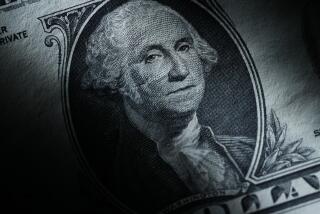Prime Cut to 6 1/4% by Chemical Bank
- Share via
NEW YORK — Responding to easing of short-term interest rates by the Federal Reserve last week, Chemical Banking Corp. on Monday lowered its prime lending rate by one-quarter percentage point to 6.25%.
The announcement by Chemical, one of the nation’s largest banks after its merger last year with Manufacturers Hanover Trust Co., put pressure on its rivals to respond. But other major banks did not immediately act to lower their key lending rate.
“It’s not unusual for one bank to come out without the others following for a day or so,” said Frank J. Barkocy, banking industry analyst and senior vice president at Advest Inc., a brokerage firm. “Bank earnings were strong in the first quarter, and that should allow banks to move.”
If the other banks follow suit, the prime--the base interest rate that banks use in pricing short-term loans--will be at its lowest level since Dec. 13, 1976.
Though a reduction in the prime has its most immediate impact on small and medium-sized business borrowers, it often eventually trickles down to consumers in mortgage, auto and other loans.
“Every little bit helps, because the economic recovery is so fragile right now,” said Wilson Lam, vice president and economist at Aubrey G. Lanston & Co., a government securities dealer. “If the other banks join in, consumer confidence, which hit a low in February, could continue to rebound.”
Irwin L. Kellner, Chemical Banking’s chief economist, attributed Chemical’s prime-rate cut to the bank’s own lower cost of funds. “Management felt it was appropriate to pass along the lower rates to our customers,” he said.
Chemical, he said, has been trying to put out the word that the credit crunch is over. On Feb. 11, the company launched a marketing blitz in which 800 lending officers armed with Nestle’s Crunch bars called on over 2,000 corporate borrowers in the New York-New Jersey-Connecticut area. The lending officers’ message: “This is the only crunch you’ll experience if you deal with Chemical.”
Although Barkocy said that it can be “a humbling experience” for a bank to cut its prime rate and not have anyone follow, Kellner had a different interpretation. “We are the biggest (retail) bank in the New York area, and if there is any discomfort, I would imagine it is on the part of our competitors,” Kellner said.
Other major banks declined comment Monday.
While analysts agreed that a cut in the prime could help consumer confidence, there was no unanimity that it would immediately stimulate flagging loan demand.
“It’s not clear that cutting the prime rate will generate additional loan demand, since credit quality is the primary consideration in lending money right now,” said Sung Won Sohn, chief economist for Norwest Corp. in Minneapolis.
The last cut in the prime rate was on Dec. 20, when banks lowered the rate a full percentage point to 6.5%. Monday’s action by Chemical followed the Fed’s move last Thursday to nudge the federal funds rate--the rate banks charge one another for overnight loans--down to 3.75% from 4%.
But if the lower prime is good news for business borrowers and, eventually, consumers, it also calls attention to the pinch that savers are currently feeling. “Many older people who live on fixed incomes are adversely affected by lower interest rates,” said Ted Bobrow, a spokesman for the American Assn. of Retired Persons in Washington.
More to Read
Inside the business of entertainment
The Wide Shot brings you news, analysis and insights on everything from streaming wars to production — and what it all means for the future.
You may occasionally receive promotional content from the Los Angeles Times.










